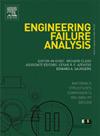陆上风力发电机组塔架拼装扩展基础结构失效分析
IF 5.7
2区 工程技术
Q1 ENGINEERING, MECHANICAL
引用次数: 0
摘要
本文对风力发电机组大型拼装摊开基础在弯矩、剪力和垂直力共同作用下的破坏行为进行了试验研究。建立了7个荷载工况,探讨了试验模型的破坏模式、开裂模式和非线性发展。结果表明,在极限状态下,试验模型的破坏受土体破坏的支配,直接导致结构承载力下降。上拔区域的悬臂根是节点的主要开裂区域,基础的倾斜率远远超过ULS规范要求。值得注意的是,通过创新的节理局部内力计算,识别出应力水平较高的特定区域,占到观察到的节理主开裂区域,便于合理设计节理,防止破坏。此外,还发现规范规定的拉控制应力下限不足以满足裂缝宽度限制,从而突出了适当的预应力在裂缝控制中的重要性。随着地基轴向载荷比的增大,关键节点最大裂缝宽度呈线性减小趋势。最后,建立了由土-结构相互作用引起的非线性临界荷载的预测公式,以防止循环荷载作用下的土壤退化。本文章由计算机程序翻译,如有差异,请以英文原文为准。
Structural failure analysis of assembled spread foundation for onshore wind turbine tower
This paper presents an experimental investigation into the failure behavior of a large-scale assembled spread foundation for wind turbines, subjected to combined loading of bending moment, shear force, and vertical force. Seven load cases are established to explore the failure mode, cracking pattern, and nonlinearity development of the test model. The results indicate that, under the ultimate limit state (ULS), failure of the test model is governed by soil damage, directly leading to a decline in the structural load-bearing capacity. The cantilever root in the uplift region is the main cracking area for the joints, and the tilt rate of the foundation far exceeds the code requirements under ULS. Notably, through innovative calculation of local internal forces at the joints, the specific areas with higher stress levels are identified, accounting for the observed primary joint cracking areas and facilitating reasonable joint design to prevent failure. Besides, it is found that the lower limit of tension control stress as per the code is insufficient to meet the crack width limits, thereby highlighting the significance of adequate prestress in crack control. Furthermore, a linear decreasing trend of maximum crack widths at key load-bearing joints with an increase in the foundation’s axial load ratio is also disclosed. Finally, a prediction formula for nonlinear critical loads resulting from soil-structure interaction is established to prevent soil degradation under cyclic loading.
求助全文
通过发布文献求助,成功后即可免费获取论文全文。
去求助
来源期刊

Engineering Failure Analysis
工程技术-材料科学:表征与测试
CiteScore
7.70
自引率
20.00%
发文量
956
审稿时长
47 days
期刊介绍:
Engineering Failure Analysis publishes research papers describing the analysis of engineering failures and related studies.
Papers relating to the structure, properties and behaviour of engineering materials are encouraged, particularly those which also involve the detailed application of materials parameters to problems in engineering structures, components and design. In addition to the area of materials engineering, the interacting fields of mechanical, manufacturing, aeronautical, civil, chemical, corrosion and design engineering are considered relevant. Activity should be directed at analysing engineering failures and carrying out research to help reduce the incidences of failures and to extend the operating horizons of engineering materials.
Emphasis is placed on the mechanical properties of materials and their behaviour when influenced by structure, process and environment. Metallic, polymeric, ceramic and natural materials are all included and the application of these materials to real engineering situations should be emphasised. The use of a case-study based approach is also encouraged.
Engineering Failure Analysis provides essential reference material and critical feedback into the design process thereby contributing to the prevention of engineering failures in the future. All submissions will be subject to peer review from leading experts in the field.
 求助内容:
求助内容: 应助结果提醒方式:
应助结果提醒方式:


